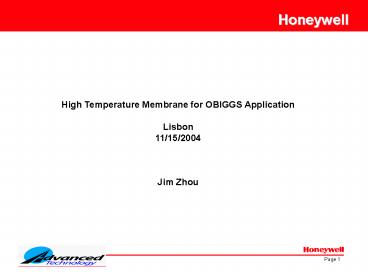Honeywell - PowerPoint PPT Presentation
Title:
Honeywell
Description:
To develop a high temperature gas separation hollow fiber membrane ... Polymer dope rate: 1.2 to 2.5 g/min/per strand. Speed: 75 to 250 ft/min(23 to 76 m/min) ... – PowerPoint PPT presentation
Number of Views:149
Avg rating:3.0/5.0
Title: Honeywell
1
Honeywell
High Temperature Membrane for OBIGGS
Application Lisbon 11/15/2004 Jim Zhou
2
Outline
- Objectives
- Why high temperature membrane?
- Fiber spinning conditions
- Test results
- Conclusions
3
Objectives
- Objectives
- To develop a high temperature gas separation
hollow fiber membrane suitable for the OBIGGS
application
- Why high temperature membrane?
- Reduce the size and volume of the OBIGG system by
taking advantage of higher gas permeability at
higher temperatures and reduced cooling
requirements at higher OBIGGS operating
temperature
4
Membrane Material Selection
Honeywells Innovative High Temperature Membrane
- High O2, N2 permeability
- High O2/N2 Selectivity
- Wet spun with very thin selective layer to
increase flux - Less susceptible to contaminants
- Large operating temperature and pressure range
5
Membranes and Membrane Modules
Nitrogen Oxygen Water Vapor
Nitrogen
Oxygen and water vapor are fast gases which
quickly permeate the membrane, allowing nitrogen
to flow through the fiber bores as the product
stream.
Feed Air
This illustration shows how fast gases like
oxygen and moisture permeate the surface of the
individual membrane fibers while nitrogen
molecules remain inside and are delivered as the
product gas.
6
Membranes and Membrane Modules
End Plate
EnrichedNitrogenProductGas
Epoxy Tube Sheet
Support Core
Epoxy TubeSheet
Oxygen-Enriched Air
Hollow Fibers
Feed Air
O-Rings
Thousands of individual fibers wrapped around a
core make up the nitrogen generating hollow
fiber membrane module. The engineering of the
module is important to maximizing the performance
of the whole system.
7
Fiber Spinning Conditions
Phase inversion/Wet spinning process
- Pros
- Can produce membrane with extremely thin
selective layer (Asymmetrical membrane structure)
- Cons
- Porous support layer may not be stable at high
temperatures - Complex spinning and solvent leaching process
- Membrane selectivity changes with the amount of
solvent left behind
8
Typical Fiber Spinning Conditions
- Fiber spinning condition ranges
- Polymer dope rate 1.2 to 2.5 g/min/per strand
- Speed 75 to 250 ft/min(23 to 76 m/min)
- Center solvent rate 0.5 to 2.0 ml/min
- Temperature Room to 100oC
- Fiber ID 100 to 160 micron
- Fiber OD 150 to 300 micron
9
Membrane Structure
- Thin skin layer with porous support
- High gas flux
10
Test Results
11
Test Results
12
Test Results
13
Air Separation Modules
14
Conclusions
- Membrane is stable at operating temperatures up
to 160C - Membrane flux increase with increase temperature
- Membrane performance influenced by spinning
conditions - High temperature membrane offers advantages over
conventional membranes
15
The Fourth Triennial International Aircraft Fire
and Cabin Safety Research Conference
The Fourth Triennial International Aircraft Fire
and Cabin Safety Research Conference































